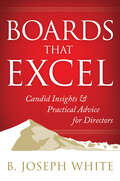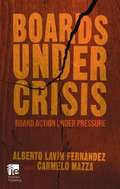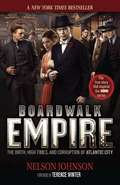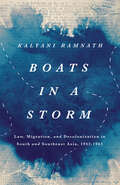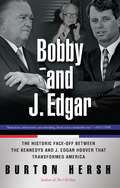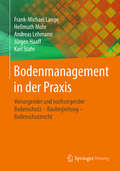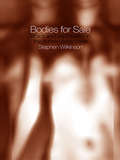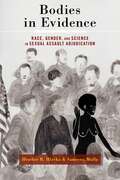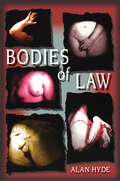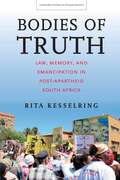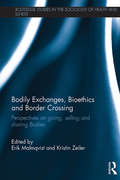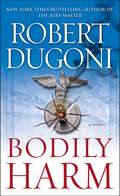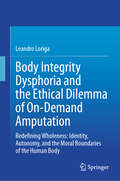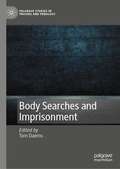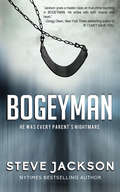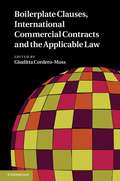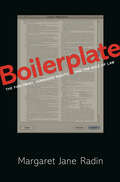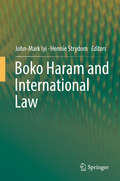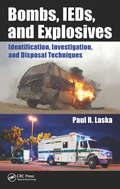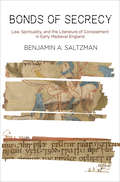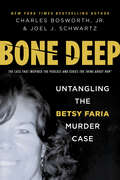- Table View
- List View
Boards That Excel: Candid Insights and Practical Advice for Directors
by B. Joseph WhiteThis is a different kind of corporate governance book. With its vivid stories and conversational tone, Boards That Excel is like sitting down with an astute and experienced friend—one who’s passionate about what corporate and nonprofit boards can contribute to their organizations’ success when they set high aspirations, are clear on purpose, and do the right things in the right way. B. Joseph White, an experienced corporate and nonprofit director and a distinguished academic, argues that boards can enable organizations to do great things, but only when directors go well beyond their duty to oversee and monitor management. White offers a road map for governance success based on his experience with two of America’s most successful companies, one public and one private. He knows governance research and distills it to a handful of truly useful insights for boards and directors. He provides clear guidance on the essential work boards must do, and, drawing on behavioral research, he describes how they can ensure the boardroom is a place of good information, thoughtful evaluation, and wise decision making. The book reports on interviews with more than a dozen high-performance board chairs, CEOs, and directors, including Siebel Systems founder Tom Siebel, legendary real estate investor Sam Zell, former Harlem Globetrotters owner Mannie Jackson, GM board chairman and former Cummins chairman and CEO Tim Solso, and volunteer (University of Illinois, University of Michigan) and corporate (Hershey, Bob Evans) director Mary Kay Haben. All speak with unusual candor on what it takes for boards and directors to excel.
Boards Under Crisis
by Alberto Lavín Fernández Carmelo MazzaAn innovative, research-based review of how boards make decisions during crises designed to offer insight and accessible theories for invested senior management facing crises situations. This book gathers recent and historical research on boardroom decision making from the field and business literature to review crises, TMT and decision making. "
Boards and Shareholders in European Listed Companies
by Massimo Belcredi Guido FerrariniWith contributions by distinguished scholars from legal and financial backgrounds, this collection of essays analyses four main topics in the corporate governance of European listed firms: (i) board structure, composition and functioning and their interaction with ownership structure; (ii) board remuneration; (iii) shareholder activism and (iv) corporate governance disclosure based on the 'comply or explain' approach. The authors provide new comparative evidence and analyse its implications for the policy debate. They challenge the conventional wisdom that corporate governance in European firms was systematically dysfunctional. While proposals aimed at increasing disclosure and accountability are usually well-grounded, caution is suggested when bringing forward regulatory changes with respect to proposals targeting specific governance arrangements, especially in the fields of board composition and shareholder activism. They argue that the 'comply or explain' principle should be retained and further efforts should be exercised to enhance disclosure.
Boardwalk Empire: The Birth, High Times, and Corruption of Atlantic City
by Nelson JohnsonTalks about the hidden history of Atlantic City,from its founding as a health resort,its golden age,its post-prohibition fall that continued for decades and its rebirth as a casino resort town.
Boats in a Storm: Law, Migration, and Decolonization in South and Southeast Asia, 1942–1962 (South Asia in Motion)
by Kalyani RamnathFor more than century before World War II, traders, merchants, financiers, and laborers steadily moved between places on the Indian Ocean, trading goods, supplying credit, and seeking work. This all changed with the war and as India, Burma, Ceylon, and Malaya wrested independence from the British empire. Set against the tumult of the postwar period, Boats in a Storm centers on the legal struggles of migrants to retain their traditional rhythms and patterns of life, illustrating how they experienced citizenship and decolonization. Even as nascent citizenship regimes and divergent political trajectories of decolonization papered over migrations between South and Southeast Asia, migrants continued to recount cross-border histories in encounters with the law. These accounts, often obscured by national and international political developments, unsettle the notion that static national identities and loyalties had emerged, fully formed and unblemished by migrant pasts, in the aftermath of empires. Drawing on archival materials from India, Sri Lanka, Myanmar, London, and Singapore, Kalyani Ramnath narrates how former migrants battled legal requirements to revive prewar circulations of credit, capital, and labor, in a postwar context of rising ethno-nationalisms that accused migrants of stealing jobs and hoarding land. Ultimately, Ramnath shows how decolonization was marked not only by shipwrecked empires and nation-states assembled and ordered from the debris of imperial collapse, but also by these forgotten stories of wartime displacements, their unintended consequences, and long afterlives.
Bobby and J. Edgar: The Historic Face-Off Between the Kennedys and J. Edgar Hoover that Transformed America
by Burton HershNOW WITH A NEW PREFACE In this riveting account of the explosive relationship between Robert F. Kennedy and J. Edgar Hoover, renowned journalist and author Burton Hersh sets their highly publicized clashes in the context of Joe Kennedy’s ongoing manipulation of Congress and his children’s careers, and his lifelong connections to organized crime. Theirs was a unique triumvirate, marked by conflict and betrayal, and culminating in a near-Shakespearean tragedy. Based on compelling new research, and told in gripping anecdotal style, Hersh chronicles the complex relationship between the two antagonists, from their early brushes during the McCarthy years to their controversial deaths.
Bodenmanagement in der Praxis: Vorsorgender und nachsorgender Bodenschutz – Baubegleitung – Bodenschutzrecht
by Karl Stahr Frank-Michael Lange Hellmuth Mohr Andreas Lehmann Jürgen HaaffDie wichtigsten Gesetze und Verordnungen werden vorgestellt und die Rechtslage an Hand aktueller Rechtssprechung dargelegt. Erkundungs- und Bewertungstechniken werden beschrieben und kommentiert und die relevanten Normen und technischen Regelwerke sind aufgef#65533;hrt. Das Buch gliedert sich in die drei Bereiche Altlasten, Abfalltechnik - soweit Bodenkundlich relevant - und Oberbodenmanagement. Letzteres wird im Zuge von Ausgleichsma#65533;nahmen zu Bauvorhaben vermehrt von zust#65533;ndigen Beh#65533;rden eingefordert.
Bodies for Sale: Ethics and Exploitation in the Human Body Trade
by Stephen WilkinsonBodies for Sale: Ethics and Exploitation in the Human Body Trade explores the philosophical and practical issues raised by activities such as surrogacy and organ trafficking. Stephen Wilkinson asks what is it that makes some commercial uses of the body controversial, whether the arguments against commercial exploitation stand up, and whether legislation outlawing such practices is really justified.In Part One Wilkinson explains and analyses some of the notoriously slippery concepts used in the body commodification debate, including exploitation, harm and consent. In Part Two he focuses on three controversial issues (the buying and selling of human kidneys, commercial surrogacy, and DNA patenting) outlining contemporary regulation and investigating both the moral issues and the arguments for legal prohibition.
Bodies in Evidence: Race, Gender, and Science in Sexual Assault Adjudication
by Heather R. Hlavka Sameena MullaWinner, 2021-2022 AES Senior Book Prize, awarded by the American Ethnological SocietyHonorable Mention, Senior Book Prize of the Association for Feminist AnthropologyUncovers how the process of sexual assault adjudication reinforces inequality and becomes a public spectacle of violenceFor victims in sexual assault cases, trials rarely result in justice. Instead, the courts drag defendants, victims, and their friends and family through a confusing and protracted public spectacle. Along the way, forensic scientists, sexual assault nurse examiners, and police officers provide their insight and expertise, shaping the story that emerges for the judge and jury. These expert narratives intersect with the stories of victims, witnesses, and their communities to reproduce our cultural understandings of sexual violence, but too often this process results in reinscribing racial, gendered, and class inequalities. Bodies in Evidence draws on observations of over 680 court appearances in Milwaukee County’s felony sexual assault courts, as well as interviews with judges, attorneys, forensic scientists, jurors, sexual assault nurse examiners, and victim advocates. It shows how forensic science helps to propagate public misunderstandings of sexual violence by bestowing an aura of authority to race and gender stereotypes and inequalities. Expert testimony reinforces the idea that sexual assault is physically and emotionally recognizable and always leaves material evidence. The court’s reliance on the presence of forensic evidence infuses these very familiar stereotypes and myths about sexual assault with new scientific authority. Powerful, unflinching, and at times heartbreaking, Bodies in Evidence reveals the human cost of sexual assault adjudication, and the social cost we all bear when investing in forms of justice that reproduce inequality and racial injustice.
Bodies of Law
by Alan HydeThe most basic assertions about our bodies--that they are ours and distinguish us from each other, that they are private and have boundaries, races, and genders--are all political theories, constructed in legal texts for political purposes. So argues Alan Hyde in this first account of the body in legal thought. Hyde demonstrates that none of the constructions of the body in legal texts are universal truths that rest solely on body experience. Drawing on an array of fascinating case material, he shows that legal texts can construct all kinds of bodies, including those that are not owned at all, that are just like other bodies, that are public, open, and accessible to others. Further, the language, images, and metaphors of the body in legal texts can often convince us of positions to which we would not assent as a matter of political theory. Through analysis of legal texts, Hyde shows, for example, how law's words construct the vagina as the most searchable body part; the penis as entirely under mental control; the bone marrow that need not be shared with a half-sibling who will die without it; and urine that must be surrendered for drug testing in rituals of national purification. This book will interest anyone concerned with cultural studies, gender studies, ethnic studies, and political theory, or anyone who has heard the phrase "body constructed in discourse" and wants to see, step by step, exactly how this is done.
Bodies of Others: The New Authoritarians, COVID-19 and the War Against the Human
by Naomi WolfThe Bodies of Others is about how we came to the harrowing civilizational crossroads at which we find ourselves - engaged in a war against vast impersonal forces with limitless power over our lives and which threaten the freedoms we have always taken for granted. In her most provocative book yet, Dr. Naomi Wolf shows how these forces—from Big Tech and Big Pharma to the CCP and our oligarchical elites—seized upon two years of COVID-19 panic in sinister new ways, to not only undermine our Republic but to fundamentally reorient human relations. Their target is humanity itself. Their end goal is to ensure that our pre-March 2020 world is gone forever. Irretrievable. To be replaced with a world in which all human endeavor—all human joy, all human fellowship, all human advancement, all human culture, all human song, all human drama, all worship, all surprise, all flirtation, all celebration—is behind a digital paywall. A world in which we will all have to ask technology's permission to be human. But we, the people of the world, did not vote to abandon our old systems and destroy our old ways so absolutely they could never be recovered. And Wolf shows how, against overwhelming odds, we still might win.
Bodies of Truth: Law, Memory, and Emancipation in Post-Apartheid South Africa
by Rita KesselringBodies of Truth offers an intimate account of how apartheid victims deal with the long-term effects of violence, focusing on the intertwined themes of embodiment, injury, victimhood, and memory. In 2002, victims of apartheid-era violence filed suit against multinational corporations, accusing them of aiding and abetting the security forces of the apartheid regime. While the litigation made its way through the U.S. courts, thousands of victims of gross human rights violations have had to cope with painful memories of violence. They have also confronted an official discourse claiming that the Truth and Reconciliation Commission of the 1990s sufficiently addressed past injuries. This book shows victims' attempts to emancipate from their experiences by participating in legal actions, but also by creating new forms of sociality among themselves and in relation to broader South African society. Rita Kesselring's ethnography draws on long-term research with members of the victim support group Khulumani and critical analysis of legal proceedings related to apartheid-era injury. Using juridical intervention as an entry point into the question of subjectivity, Kesselring asks how victimhood is experienced in the everyday for the women and men living on the periphery of Cape Town and in other parts of the country. She argues that the everyday practices of the survivors must be taken up by the state and broader society to allow for inclusive social change in a post-conflict setting.
Bodies, Territories and Serious Violations of Human Rights in Mexico (SpringerBriefs in Criminology)
by Miguel Angel Martínez MartínezThis book seeks to contribute to the analysis of the serious violations of human rights in Mexico during the processes of democratic transition and the "War on Drugs" by taking bodies and territories as archives of the crimes committed by the Mexican State in the last decades. The text presents an analysis of the disappearance of persons, forced internal displacement, and gender violence as systematic expressions of State violence. These fields of research allow us to point out tensions between social practices and the institutional fragility that systematically denies human rights violations while at the same time ratifies and celebrates them.The thematic knotting between bodies and territories is anchored in the processes of shaping a memory that expresses State violence and presents the silenced resistances of minority social groups that elude the traditional forms of registration, control and collection of data. From these coordinates, body-territories are approached as scenarios where intersectionally-knotted violences unfold. The theoretical approaches considered are mobilized through a critical approach to capitalism, colonialism and patriarchy in order to analyze public policies and narratives related to the protection of bodies-territories, as well as the responses to the needs, interests and preferences of different groups and individuals whose lives are marked by the experience of serious human rights violations. Finally, this approach also considers the new ways in which crimes against humanity unfold in situations of democratic transition, as well as the forms of symbolic exchanges in the transmission of meaning and community bonding. Bodies, Territories and Serious Violations of Human Rights in Mexico will be of interest to academic researchers and graduate students in different fields of knowledge, such as criminology, sociology, history, anthropology, philosophy, psychology and the interdisciplinary field of human rights studies.
Bodily Exchanges, Bioethics and Border Crossing: Perspectives on Giving, Selling and Sharing Bodies
by Erik Malmqvist Kristin ZeilerMedical therapy, research and technology enable us to make our bodies, or parts of them, available to others in an increasing number of ways. This is the case in organ, tissue, egg and sperm donation as well as in surrogate motherhood and clinical research. Bringing together leading scholars working on the ethical, social and cultural aspects of such bodily exchanges, this cutting-edge book develops new ways of understanding them. Bodily Exchanges, Bioethics and Border Crossing both probes the established giving and selling frameworks for conceptualising bodily exchanges in medicine, and seeks to develop and examine another, less familiar framework: that of sharing. A framework of sharing can capture practices that involve giving up and giving away part of one’s body, such as organ and tissue donation, and practices that do not, such as surrogacy and research participation. Sharing also recognizes the multiple relationalities that these exchanges can involve and invites inquiry into the context in which they occur. In addition, the book explores the multiple forms of border crossing that bodily exchanges in medicine involve, from the physical boundaries of the body to relational borders – as can happen in surrogacy – to national borders and the range of ethical issues that these various border-crossings can give rise to. Engaging with anthropology, sociology, philosophy, and feminist and postcolonical perspectives, this is an original and timely contribution to contemporary bioethics in a time of increasing globalization. It will be of use to students and researchers from a range of humanities and social science backgrounds as well as medical and other healthcare professionals with an interest in bioethics.
Bodily Harm: A Novel (David Sloane Ser. #3)
by Robert DugoniNew York Times bestselling author Robert Dugoni returns with his most exhilarating legal thriller to date, a pulse-pounding story of corporate greed, espionage, and the lengths one man is willing to go for justice.Bodily Harm opens with a big win for David Sloane and his new partner, Tom Pendergrass, in a malpractice case centered on the death of a young child. But on the heels of this seeming victory, an unlikely character—toy designer Kyle Horgan— comes forward to tell Sloane that he&’s gotten it all wrong: Horgan&’s the one who&’s truly responsible for the little boy&’s death and possibly others—not the pediatrician Sloane has just proven guilty. Ordinarily, Sloane might have dismissed such a person as a crackpot, but something about this case has always troubled him—something that he couldn&’t quite pinpoint. When Sloane tries to follow up with Horgan, he finds the man&’s apartment a shambles— ransacked by unknown perpetrators. Horgan has vanished without a trace. Together with his longtime investigative partner Charles Jenkins, Sloane reexamines his clients&’ son&’s death and digs deeper into Horgan&’s claims, forcing him to enter the billion-dollar, cutthroat toy industry. As Sloane gets closer to the truth, he trips a wire that leads to a shocking chain of events that nearly destroys him. To get to the bottom of it all and find justice for the families harmed, Sloane must keep in check his overwhelming desire for revenge. Full of nail-bitingly tense action scenes as well as edge-of-your-seat courtroom drama, Bodily Harm finds Robert Dugoni at the very top of his game.
Body Integrity Dysphoria and the Ethical Dilemma of On-Demand Amputation: Redefining Wholeness: Identity, Autonomy, and the Moral Boundaries of the Human Body
by Leandro LorigaThis book, explores the complex moral and ethical dilemmas surrounding Body Integrity Dysphoria (BID) and its recent classification in the ICD-11. The examination offers a pioneering view into a condition that remains deeply controversial within medical and public discourse. BID is characterised by a persistent desire to acquire a physical impairment, often through amputation. Such a situation forces the medical world to take a stance by either granting the amputation request or rejecting it with the risk of pushing individuals toward self-made solutions. Through a review of the contemporary understanding of BID as well as original data obtained during extensive fieldwork with medical professionals, this book addresses the ethical and moral aspects of the condition. Fundamental questions are posed about the relationship between bodily autonomy and embodiment, identity and gender, well-being and moral responsibility, and how these elements intertwine, shape and are shaped by sociocultural understanding of illness and body. The book aims to move beyond traditional understandings of body functionality to consider the implications of autonomy and the extent to which an individual considered mentally and physically sound can dispose of one's own body within the contemporary medical paradigm. This is done to question long-standing assumptions about bodily integrity and traditional views on the wholeness and naturalness of the human form. As postmodern theories challenge established frameworks, a paradigm shift emerges in medical and societal approaches to identity, embodiment, and impairment, and this needs to be addressed. Drawing on insights from medicine, psychology, sociology, and ethics, this book situates BID within a broader cultural and philosophical context. It raises essential questions about where individuals' rights intersect with medical responsibility and societal perceptions of normalcy and health. By doing so, the book provokes readers to reconsider the boundaries between health, pathology, and self-determination.
Body Searches and Imprisonment (Palgrave Studies in Prisons and Penology)
by Tom DaemsThis book explores and addresses body search practices in prison environments from different angles (criminology, sociology, human rights and law) and discusses such practices in different national contexts within Europe. Body searches are widely used in prison systems across the globe: they are perceived as indispensable to prevent forbidden substances, weapons or communication devices from entering the prison. However, these are also invasive and potentially degrading control techniques. It should not come as a surprise, then, that body searches are deeply contested security measures and that they have been widely debated and regulated. What makes theses control measures problematic in a prison context? How do these practices come to be regulated in an international and European context? How are rules translated into national law? To what extent are laws and rules respected, bent, circumvented and denied? And what does the future hold for body searches?
Body and Soil
by Ralph McInernyMARRIAGE MADE IN HELL... “The prosecutor is going to suggest you went home, killed Hal, and then went to Sylvia’s.” “But I didn’t! It’s not true.” “And our job is to make sure people see that you didn’t kill him. We’re going to have to do better than saying you were driving around for two hours trying to think. So let’s start there. You’re going to have to remember that drive.” “Andrew, I haven’t been arrested. Nobody has accused me of anything. Does a person have to prove she’s innocent?” “Let’s call it a day then. But I want you to try to reconstruct the time between leaving the club and getting to Sylvia’s. You weren’t drunk, were you?” “I’ve never been drunk a day in my life.” “Do me a favor, Pauline. Don’t say that under oath.”
Bogeyman: He Was Every Parent's Nightmare
by Steve JacksonThe New York Times bestselling author &“gives a master class on true crime reporting in Bogeyman. He writes with both muscle and heart&” (Gregg Olsen, #1 New York Times bestselling author). Bogeyman describes in dramatic detail and with heartrending poignancy the efforts of tenacious Texas lawmen to solve the cold case murders of three little girls and hold serial child killer David Elliot Penton accountable for his horrific crimes. From the book: &“For years he&’d stalked elementary schools and playground looking for young girls from low-income neighborhoods to abduct, rape and murder. He thought of them as &‘throwaway kids&’—hardly missed, and soon forgotten, except by those who loved them. He was every parent&’s worst nightmare. The bogeyman they warned their children about . . . the fiend who lurked outside bedroom windows.&” &“Absorbing and haunting! Bogeyman spills creepily across the page with Steve Jackson&’s hellacious verve and insight, reminding us there are few better explorers of the American berserk.&”—Ron Franscell, bestselling author of Alice & Gerald: A Homicidal Love Story &“Steve Jackson&’s latest, Bogeyman, reveals a living, breathing nightmare that haunted parents, as well as detectives. Be sure to add it to your reading list if you&’re a fan of true crime books.&”—Aaron Habel, host of Generation Why Podcast &“There are true crime books that just lay out the facts, and there are true crime books that pull you deeply into a world. Jackson writes deeply . . . It&’s all in Bogeyman, a fascinating, well-paced read about the lows and highs of cold case investigations.&”—Katherine Ramsland, bestselling author and professor of forensic psychology, in Psychology Today
Boilerplate Clauses, International Commercial Contracts and the Applicable Law
by Giuditta Cordero-MossWith the aim of creating an autonomous regime for the interpretation and application of the contract, boilerplate clauses are often inserted into international commercial contracts without negotiations or regard for their legal effects. The assumption that a sufficiently detailed and clear language will ensure that the legal effects of the contract will only be based on the contract, as opposed to the applicable law, was originally encouraged by English courts, and today most international contracts have these clauses, irrespective of the governing law. This collection of essays demonstrates that this assumption is not fully applicable under systems of civil law, because these systems are based on principles, such as good faith and loyalty, which contradict this approach.
Boilerplate: The Fine Print, Vanishing Rights, and the Rule of Law
by Margaret Jane RadinWhy the increasing use of boilerplate is eroding our rightsBoilerplate—the fine-print terms and conditions that we become subject to when we click "I agree" online, rent an apartment, enter an employment contract, sign up for a cellphone carrier, or buy travel tickets—pervades all aspects of our modern lives. On a daily basis, most of us accept boilerplate provisions without realizing that should a dispute arise about a purchased good or service, the nonnegotiable boilerplate terms can deprive us of our right to jury trial and relieve providers of responsibility for harm. Boilerplate is the first comprehensive treatment of the problems posed by the increasing use of these terms, demonstrating how their use has degraded traditional notions of consent, agreement, and contract, and sacrificed core rights whose loss threatens the democratic order.Margaret Jane Radin examines attempts to justify the use of boilerplate provisions by claiming either that recipients freely consent to them or that economic efficiency demands them, and she finds these justifications wanting. She argues, moreover, that our courts, legislatures, and regulatory agencies have fallen short in their evaluation and oversight of the use of boilerplate clauses. To improve legal evaluation of boilerplate, Radin offers a new analytical framework, one that takes into account the nature of the rights affected, the quality of the recipient's consent, and the extent of the use of these terms. Radin goes on to offer possibilities for new methods of boilerplate evaluation and control, among them the bold suggestion that tort law rather than contract law provides a preferable analysis for some boilerplate schemes. She concludes by discussing positive steps that NGOs, legislators, regulators, courts, and scholars could take to bring about better practices.
Boko Haram and International Law
by John-Mark Iyi Hennie StrydomThis book focuses on Boko Haram and terrorism in Nigeria, framing the conflict in an international law context. It analyses the nature of political violence and the dominant roles of a violent nation-state (in both colonial and post-colonial experiences) and the rise of terrorism in Nigeria. The book unearths embedded evidence of religious nepotism on the part of state officials using such state institutions as Islamic Preaching Boards to promote one Islamic sect over another in mainly Muslim Northern Nigeria. The book offers insights into this subtle sectarian divide and how this and other ‘subterranean’ elements have contributed to the rise of Boko Haram in Northern Nigeria beyond the dominant poverty-terrorism nexus narrative. Furthermore, the book analyses the various components of Boko Haram’s radical ideology, situates them in Islamic Jurisprudence, and examines the philosophy of the group (both in doctrine and practice) – their interpretation of the Koran and the waging of Jihad, and the extent to which they conform to the Islamic Sect Boko Haram claims to follow. The book then examines the basic doctrinal features and characteristics of Boko Haram – waging Jihad, prohibiting revealing dresses for women and mixing of genders, rejecting western values and institutions, denouncing scientific inquiry and democracy, hostage taking, sexual exploitation of captives and other aspects of jus ad bellum and jus in bello in Islamic jurisprudence and international law. Finally, the book analyses the plight of vulnerable groups such as internally displaced persons, the atrocities committed against women and girls in the Boko Haram insurgency and the (in)ability of international law to enforce the protections offered to the victims. From the perspective of critical intellectual inquiry, the book also challenges a number of fundamental assumptions and encourages us to revisit our legal characterisation of certain concepts such as “gender-based crimes”. It then goes further to analyse some legal grey areas in the Boko Haram insurgency such as the legal status of the Civilian Joint Task Force (CJTF) and the legal framework for holding members accountable for violations of international human rights and humanitarian law. Overall, the book represents a valuable contribution to scholarship, deepens our understanding and delineates how international law could respond to the Boko Haram insurgency in Nigeria in particular and terrorism in Africa in general.
Bombs, IEDs, and Explosives: Identification, Investigation, and Disposal Techniques
by Paul R. LaskaA guide on procedures, administration, and equipment, Bombs, IEDs, and Explosives: Identification, Investigation, and Disposal Techniques introduces concepts, basic knowledge, and necessary skill sets for bomb technicians. It covers topics such as training resources, bomb threat and incident response, legal aspects of bomb disposal, explosives and
Bonds of Secrecy: Law, Spirituality, and the Literature of Concealment in Early Medieval England (The Middle Ages Series)
by Benjamin A. SaltzmanWhat did it mean to keep a secret in early medieval England? It was a period during which the experience of secrecy was intensely bound to the belief that God knew all human secrets, yet the secrets of God remained unknowable to human beings. In Bonds of Secrecy, Benjamin A. Saltzman argues that this double-edged conception of secrecy and divinity profoundly affected the way believers acted and thought as subjects under the law, as the devout within monasteries, and as readers before books. One crucial way it did so was by forming an ethical relationship between the self and the world that was fundamentally different from its modern reflex. Whereas today the bearers of secrets might be judged for the consequences of their reticence or disclosure, Saltzman observes, in the early Middle Ages a person attempting to conceal a secret was judged for believing he or she could conceal it from God. In other words, to attempt to hide from God was to become ensnared in a serious sin, but to hide from the world while deliberately and humbly submitting to God's constant observation was often a hallmark of spiritual virtue.Looking to law codes and religious architecture, hagiographies and riddles, Bonds of Secrecy shows how legal and monastic institutions harnessed the pervasive and complex belief in God's omniscience to produce an intense culture of scrutiny and a radical ethics of secrecy founded on the individual's belief that nothing could be hidden from God. According to Saltzman, this ethics of secrecy not only informed early medieval notions of mental activity and ideas about the mind but also profoundly shaped the practices of literary interpretation in ways that can inform our own contemporary approaches to reading texts from the past.
Bone Deep: Untangling the Twisted True Story of the Tragic Betsy Faria Murder Case
by Joel Schwartz Charles Henry Bosworth Jr.THE TRUE STORY OF THE CASE THAT IS THE SUBJECT OF NBC&’S MARQUEE MINI-SERIES "THE THING ABOUT PAM" STARRING RENEE ZELLWEGER AS PAM HUPP AND JOSH DUHAMEL AS JOEL SCHWARTZ.The explosive, first-ever insider&’s account of the case that&’s captivated millions — the murder of Betsy Faria and the wrongful conviction of her husband — told by Joel J. Schwartz, the defense attorney who fought for justice on behalf of Russel Faria, and New York Timesbestselling author Charles Bosworth Jr.On December 27th, 2011, Russell Faria returned to his Troy, Missouri, home after his weekly game night with friends to an unthinkable, grisly scene: His wife, Betsy, lay dead, a knife still lodged in her neck. She&’d been stabbed fifty-five times. First responders concluded that Betsy was dead for hours when Russ discovered her. No blood was found implicating Russ, and surveillance video, receipts, and friends&’ testimony all supported his alibi. Yet incredibly, police and the prosecuting attorney ignored the evidence. In their minds, Russ was guilty. But prominent defense attorney Joel J. Schwartz quickly recognized the real killer. The motive was clear. Days before her murder, the terminally ill Betsy replaced her husband with her friend, Pamela Hupp, as her life insurance beneficiary. Still, despite the prosecution&’s flimsy case and Hupp&’s transparent lies, Russ was convicted—leaving Hupp free to kill again. Bone Deep takes readers through the perfect storm of miscalculations and missteps that led to an innocent man&’s conviction—and recounts Schwartz&’s successful battle to have that conviction overturned. Written with Russ Faria&’s cooperation, and filled with chilling new revelations and previously undisclosed evidence, this is the story of what can happen when police, prosecutor, judge, and jury all fail in their duty to protect the innocent—and let a killer get away with murder.&“Fans of Dateline will be interested in this work, which will likely only grow in popularity when the miniseries The Thing About Pam, starring Renée Zellweger, premieres in March 2022.&” —Library Journal&“Filled with chilling new revelations and previously undisclosed evidence, this is the story of what can happen when police, prosecutor, judge, and jury all fail in their duty to protect the innocent—and let a killer get away with murder. This book is an explosive, insider&’s account of a case that continues to fascinate the public. We highly recommend it.&” —Mystery Tribune&“An engaging true-crime book that exposes failures in the American criminal justice system while putting a human face on those involved and is recommended to those that enjoy well-researched books.&” —Mystery and Suspense&“If you are interested in justice, in criminal profiling, in trial procedures, the dynamics between the judge, the defense, and the prosecution, this book is for you.&” —Defrosting Cold Cases
